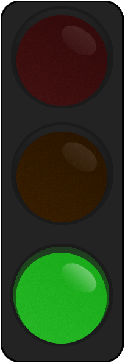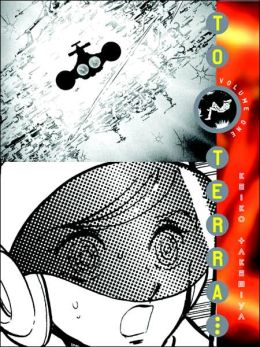TO TERRA...(Terra e...), by Keiko Takemiya. First published in 1977. First published in North America in 2007.
STORY:
Somewhere in the future, the Earth is at absolute limits. To help conserve the planet, humanity takes off for the stars. There they establish the age of Superior Domination, where children are bred by a universal computer, placed with foster parents, and then as teenagers are placed on adult colonies where the computer determines who amongst them is worthy of being sent back to Earth, or "Terra." What the computers could not anticipate was the creation of the Mu, physically handicapped individuals who also possess powerful psychic and telekinetic powers. The Mu are exiles from humanity as a whole, but they too harbor plans and aspirations to return to Terra.
The story focuses on two young boys: Jomy Marcus Shin, a 14 year old on the cusp of his Maturity Check, and Keith Anyan, a boy on the fast track to leadership. Jomy is brash, moody, and rebellious, and discovers that he is in fact a Mu. He is rescued by a hidden Mu ship only to discover that his powers are not just a quirk, but may represent the future of the Mu. Keith, on the other hand, is a brilliant student on his colony but is distant and cold with others. It takes a prodigy by the name of Seki Ray Shiroe to make Keith start questioning both the order of his society as well as his own past.
PLOT:
It's not unusual to find a sci-fi story about one or more people rebelling against an oppressive or tyrannical government both inside and outside of manga. To Terra distinguishes itself from the pack by exploring this well-worn brand of conflict from both sides, from the views of both the oppressed (the Mu) and the oppressors (the humans). By doing so, she gives this old conflict some moral complexity and ambiguity, making it less a tale of Good vs. Evil and more about two souls who want to explore and break out of the limits set by their own societies.
It certainly looks like a Good vs. Evil story at the beginning, with Jomy representing the Good (albeit a moody, whining sort of Good) and the adults representing the Evil. Then he is shanghaied by the Mu and all but forced into becoming their leader, since he is the first Mu to possess both great mental powers and a physically hale body. My only problem with that is that once Jomy becomes their leader, he seems to lose what personality he had for a good chunk of the volume and accepts the role of leader without question.
He gets better after a flash forward, where we see hints of the old Jomy as he butts heads with the Mu leaders over if it would be better to establish a new home world or to keep pursuing a return to Terra. Jomy's journey from boy to man and from skeptic to leader would be a perfectly fine story arc on its own, but Takemiya is willing to give the story greater depth by looking at things from the human's side of things by looking at Keith.
Keith seems to be the perfect example of non-Mu humanity, being a top student and athlete, albeit one with few acquaintances and no friends. He's also a common character in science fiction, one who is a functioning member of an oppressive society until his eyes are opened to the truth. The truth in this case comes from Seki, who not only beats Keith in practically every field but also questions and rebels against the system and the computers that control everyone's life, and Keith's irritation at Seki soon transforms into questions of his own about himself and his fate.
By showing Keith's story, Takemiya humanizes both sides of the human/Mu conflict. We see that those under SD control are not all happy, mindless drones - there are those within the system who question it and their own purpose within it. Keith and Jomy end up being parallels to one another, despite their never meeting - both are young and gifted, both quickly become leaders within their own societies, and both find themselves questioning the morality and direction of their respective cultures. It's unknown at this point whether Keith and Jomy will meet, but I can only hope that if they do, the results are just as fascinating and complex as their lives so far have been separately.
ART:
Being a manga from the 1970s, it may take a modern reader some time to get used to Takemiya's now old-fashioned style. Like most older mangaka, Takemiya takes some cues from Tezuka, particularly in their similiarly and somewhat cartoonish character designs. Still, there is a delicacy to Takemiya's linework, and the dark glittering eyes of her characters are very much a visual signature of 1970s shoujo.
There are some beautiful vistas in this manga, be they the abstract recesses of a character's mind or the vast scope of space and machinery. Takemiya puts a lot of detail into the planets and spaceships her characters inhabit both inside and out. Her page composition complements the beauty of her artwork as well, as the panels tend to be big and loosely bordered, allowing for a lot of layering and lovely-looking montages. She takes advantage of all that space with plenty of one- and two-page spreads of space itself, which helps to highlight the isolation of both human and Mu, as well as the very literal distance between both parties and their mutual goal of Terra.
Takemiya's artwork may be a touch old-fashioned, but it's also very beautiful and evocative, using
scale and sheer artistic skill to enhance the drama and conflict of her characters.
PRESENTATION:
This was released early in the life of Vertical, when most of their manga covers took a more Pop Art influenced approach, contrasting the title with selected panels of the work inside. This was also the time where they would put brief blurbs about selected cast members on the back, but as they only cover about four or five characters at a time, they feel rather incomplete.
RATING:
 This title has earned its classic status by take a well-worn sci-fi set up and turning it instead into two parallel tales of opposing forces, with two future leaders who are sowing the seeds of rebellion within their own cultures. This story is in turn complemented by its beautiful artwork, which gives their futuristic world a sense of both scale and beauty. I cannot recommend this series hard enough.
This title has earned its classic status by take a well-worn sci-fi set up and turning it instead into two parallel tales of opposing forces, with two future leaders who are sowing the seeds of rebellion within their own cultures. This story is in turn complemented by its beautiful artwork, which gives their futuristic world a sense of both scale and beauty. I cannot recommend this series hard enough.This series was released by Vertical. All 3 volumes were released, but all are currently out of print.
You can purchase manga like this and much more through RightStuf.com!

I aspect I find interesting about To Terra is how it's a combination of sorts of both shojo and shonen manga from the period. The plot, with it's psychics and sci-fi setting, shows a strong influence from certain shonen titles from around the same period. The art style, on the other hand, is totally 70s shojo, from the character designs to the panel layouts. I think it makes for an interesting comic in the end.
ReplyDelete